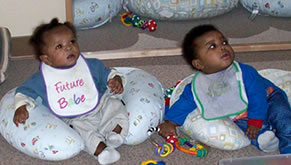Life Outcomes Significantly Determined by First Grade
You probably know the statistics: Milwaukee is the fourth poorest city in the U.S. with more than a quarter of its African-American children living in single-mother homes, more than half living in poverty, and fewer than half graduating high school. Numbers like these exist in cities across the U.S. and their devastating impact is felt by all of us, no matter where we live.
Fortunately, we need not throw up our hands in despair. We do know a major part of the solution: quality early childhood education.
Studies on infants and toddlers in the areas of brain development, joint attention, secure attachment, continuity of care, and language and literacy demonstrate that social, emotional and intellectual learning begin at birth.
By the age of three, the vocabulary of a child from a professional family is more than four times that of a child from a family on welfare. This puts the low-income child at a great disadvantage academically, a disadvantage that increases over time without proper educational intervention.
Data from longitudinal studies show that a host of societal issues – poverty, crime, teen pregnancy, school dropout rates, neglect/abuse of children, lack of skilled workers, and more – are addressed by focusing on the development of all our children, beginning at birth.
The social, emotional and intellectual foundation developed in those early years becomes the critical factor for future development and social integration. Therefore, the stunning reality is that life outcomes are significantly determined by the time a child reaches first grade.
Quantifiable Outcomes from Early Childhood Programs
Early childhood programs are the most cost-effective way to ensure the healthy development of children in poverty and offer the greatest social and economic returns to society.
Studies such as the Abecedarian Project, HighScope Perry Preschool Project, Chicago Parent-Child Centers, and Early Head Start Research and Evaluation Project demonstrate that quality early childhood education produces positive outcomes such as:
| INCREASED | REDUCED |
| – Academic Performance | – Grade Repetition |
| – Graduation Rates | – Special Education Costs |
| – College Attendance | – Teenage Pregnancy |
| – Workforce Readiness | – Neglect/Abuse of Children |
| – Job Productivity | – Crime Rates |
| – Community Engagement | – Welfare Dependency |
| – Lifetime Income | – Job Training Costs |
Statistical outcomes from these studies include:
| – High school graduation | 31% | increase |
| – Skilled job or higher education | 68% | increase |
| – Home ownership as adult | 177% | increase |
| – Monthly income at least $2,000 | 314% | increase |
| – Incidence of repeating grades | 44% | reduction |
| – Need for special education | 48% | reduction |
| – Welfare recipient as adult | 51% | reduction |
| – Misdemeanor offenses | 52% | reduction |
| – Felony offenses | 53% | reduction |
To learn more about these studies, visit
http://www.fpg.unc.edu/~abc/,
http://www.highscope.org/Content.asp?ContentId=219,
http://www.waisman.wisc.edu/cls/cbaexecsum4.html,
http://www.acf.hhs.gov/programs/opre/ehs/ehs_resrch/.
The Business Case – An Economic Analysis
Although calculations of the return on investment from early childhood education are complex, efforts have repeatedly shown that such investments return to society $4-$8 for every dollar invested – and that’s only during the first 25 years of the at-risk child’s life.
For a longer-range view, consider the analysis given in September, 2010 by Nobel laureate and University of Chicago economist James Heckman, whose life’s work is studying investments in human capital. In his report to the National Commission on Fiscal Responsibility and Budget Reform, Heckman wrote:
How can we best invest in human capital development to increase workforce capabilities, raise productivity and social cohesion and assure America’s economic competitiveness in the global economy? Data from economists, social scientists and medical experts conclusively shows that the answer is to invest in comprehensive early childhood development—from birth to age five—particularly in disadvantaged children and their families.[1]
Heckman goes on to quantify the economic benefit:
The rate of return for investment in quality early childhood education is 10% per annum. This rate of return is exponential and highly valuable: Every dollar invested in early childhood education returns ten cents annually for the life of the child.
With the equation for simple compounding of interest, we see that an $8,000 investment at birth, with a 10% annual return compounded over 65 years, provides nearly 100 times ($789,395) the amount by age 65.[2]
With a return of nearly 100 times its value over the life of the child, it’s not surprising that Heckman believes high-quality early education programs have the highest rate of return of any societal investment. Heckman concludes:
It is quite clear from an economic standpoint. We can gain money by investing early to close disparities and prevent achievement gaps, or we can continue to drive up deficit spending by paying to remediate disparities when they are harder and more expensive to close. Either way we are going to pay. And we’ll have to do both for a while. But there is an important difference between the two. Investing early allows us to shape the future and build equity; investing later chains us to fixing the missed opportunities of the past – for which we will pay dearly.[1]
This is why an investment in Malaika Early Learning Center is probably the best investment you can make.
[1] Ibid, p.10
Report to the National Commission on Fiscal Responsibility and Budget Reform, September 20, 2010, p.1-2, http://www.heckmanequation.org/system/files/Federal-Commision_9-1-2010FINAL%20_3_.pdf

